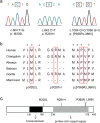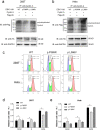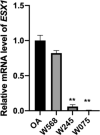Association of ESX1 gene variants with non-obstructive azoospermia in Chinese males
- PMID: 33633269
- PMCID: PMC7907365
- DOI: 10.1038/s41598-021-84182-0
Association of ESX1 gene variants with non-obstructive azoospermia in Chinese males
Abstract
Genetic factors are one of the most important causes of non-obstructive azoospermia (NOA). ESX1 is an X-linked testis-biased expressed gene, and a potential biomarker for testicular sperm retrieval in NOA patients, yet few systematic studies have investigated its association with NOA. Here, we performed selected exonic sequencing in a large cohort of Chinese males, and four novel missense mutations (including one compound mutation), one novel synonymous mutation of ESX1 unique to NOA patients were identified. We analyzed the effects of ESX1 mutations on cyclin A degradation and cell cycle progression by immunoprecipitation assay and flow cytometry, and found that the compound mutant p.[P365R; L366V] ESX1 compromised the stabilizing effect of ESX1 on polyubiquitinated cyclin A, thereby causing the failure of M phase arrest in cells. Further studies showed that the deleterious effect of the compound mutations on ESX1 protein function was attributed to p.P365R but not p.L366V alteration. The novel ESX1 mutation p.P365R might confer high risk for NOA in Han Chinese population, probably via affecting cell cycle control.
Conflict of interest statement
The authors declare no competing interests.
Figures






Similar articles
-
ESX1 mRNA expression in seminal fluid is an indicator of residual spermatogenesis in non-obstructive azoospermic men.Hum Reprod. 2014 Dec;29(12):2620-7. doi: 10.1093/humrep/deu261. Epub 2014 Oct 14. Hum Reprod. 2014. PMID: 25316452
-
Sequencing of a 'mouse azoospermia' gene panel in azoospermic men: identification of RNF212 and STAG3 mutations as novel genetic causes of meiotic arrest.Hum Reprod. 2019 Jun 4;34(6):978-988. doi: 10.1093/humrep/dez042. Hum Reprod. 2019. PMID: 31125047
-
ESX1 gene expression as a robust marker of residual spermatogenesis in azoospermic men.Hum Reprod. 2010 Jun;25(6):1398-403. doi: 10.1093/humrep/deq074. Epub 2010 Mar 31. Hum Reprod. 2010. PMID: 20356899
-
Sperm recovery and ICSI outcomes in men with non-obstructive azoospermia: a systematic review and meta-analysis.Hum Reprod Update. 2019 Nov 5;25(6):733-757. doi: 10.1093/humupd/dmz028. Hum Reprod Update. 2019. PMID: 31665451
-
[Predictive factors of testicular sperm extraction in men with non-obstructive azoospermia].Zhonghua Nan Ke Xue. 2016 May;22(5):462-6. Zhonghua Nan Ke Xue. 2016. PMID: 27416674 Review. Chinese.
Cited by
-
Whole-exome sequencing identifies rare recessive variants in azoospermia patients from consanguineous Pakistani families.Mol Genet Genomics. 2024 Dec 3;299(1):111. doi: 10.1007/s00438-024-02205-7. Mol Genet Genomics. 2024. PMID: 39625557
-
ESX1 gene as a potential candidate responsible for male infertility in nonobstructive azoospermia.Sci Rep. 2023 Oct 2;13(1):16563. doi: 10.1038/s41598-023-43854-9. Sci Rep. 2023. PMID: 37783880 Free PMC article.
-
Toward clinical exomes in diagnostics and management of male infertility.Am J Hum Genet. 2024 May 2;111(5):877-895. doi: 10.1016/j.ajhg.2024.03.013. Epub 2024 Apr 12. Am J Hum Genet. 2024. PMID: 38614076 Free PMC article.
-
Whole-genome sequencing identifies new candidate genes for nonobstructive azoospermia.Andrology. 2022 Nov;10(8):1605-1624. doi: 10.1111/andr.13269. Epub 2022 Sep 7. Andrology. 2022. PMID: 36017582 Free PMC article.
-
Predictors of Successful Testicular Sperm Extraction: A New Era for Men with Non-Obstructive Azoospermia.Biomedicines. 2024 Nov 25;12(12):2679. doi: 10.3390/biomedicines12122679. Biomedicines. 2024. PMID: 39767586 Free PMC article. Review.
References
Publication types
MeSH terms
Substances
LinkOut - more resources
Full Text Sources
Other Literature Sources
Molecular Biology Databases

